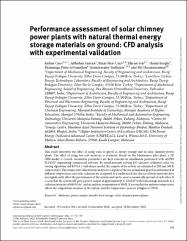Performance assessment of solar chimney power plants with natural thermal energy storage materials on ground: CFD analysis with experimental validation

Göster/
Erişim
info:eu-repo/semantics/openAccessTarih
2022Yazar
Cüce, ErdemSaxena, Abhishek
Cüce, Pınar Mert
Şen, Harun
Eroğlu, Hasan
Selvanathan, Shanmuga Priya
Sudhakar, Kumarasamy
Hasanuzzaman, Md.
Üst veri
Tüm öğe kaydını gösterKünye
Cuce, E., Saxena, A., Cuce, P.M., Sen, H., Eroglu, H., Selvanathan, S.P., Sudhakar, K. & Hasanuzzaman, M. (2022). Performance assessment of solar chimney power plants with natural thermal energy storage materials on ground: CFD analysis with experimental validation. International journal of Low-Carbon Technologies, 17, 752-759. https://doi.org/10.1093/ijlct/ctac001Özet
This study interprets the effect of using sand or gravel as energy storage unit in solar chimney power plants. The effect of using low-cost materials is evaluated. Based on the Manzanares pilot plant, a 3D CFD model is created. Geometric parameters are kept constant in simulations performed with ANSYS FLUENT engineering commercial software. By simultaneously solving DO (discrete ordinates) solar ray tracing algorithm and RNG k-epsilon turbulence model, the outputs of the system are examined at 290 and 300 K temperatures. The temperature distribution and power outputs of the use of sand and gravel as soil material at different temperatures and solar radiation are compared. It is understood that the use of both materials does not significantly affect the performance of the system and can be used economically instead of each other. It is seen that the system will give a power output of approximately 41.636 kW with both storage materials at a radiation intensity of 800 W/m(2) and an ambient temperature of 300 K. It is seen that the ambient temperature affects the temperature increase in the system, and the temperature increase is higher at 290 K.

















